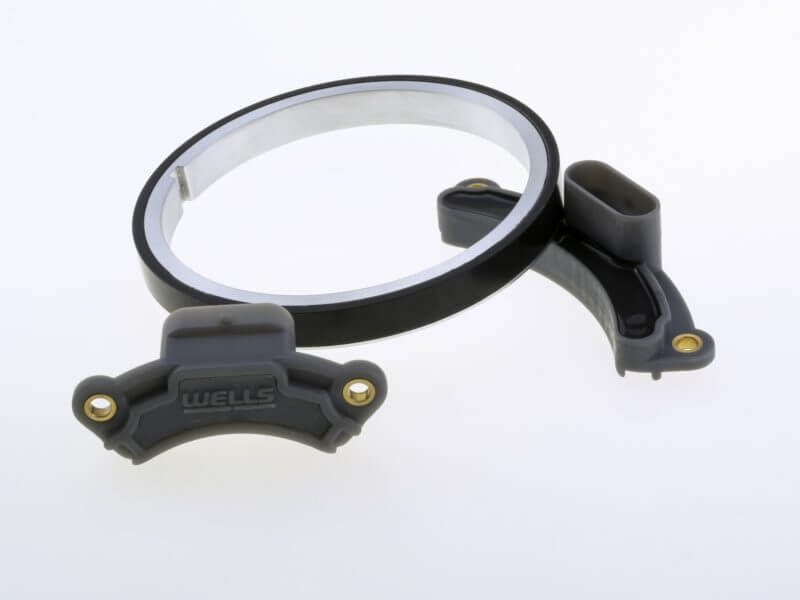
In the electric vehicle (EV) world, battery technology and charging time attract most of the attention but motor control is almost as important. This requires precise knowledge of magnetic pole speed and position, a function performed until now by variable reluctance (VR) resolvers. Wells Engineered Products has developed a new type of rotary position sensor that supersedes this older technology. Here are the details.
Background
Global electric vehicle (EV) sales totaled around 3 million in 2020, according to IHS Markit, and that number seems set to soar. Government regulation of internal combustion is a driver in some parts of the world, but consumer interest is increasing too. While range, charging and of course cost, remain concerns for buyers, people who’ve driven an EV prefer the driving experience. EVs are quiet and quick, and the smooth torque delivery makes driving more fun.
Most EVs use one of three types of traction motor. (Some combine types within a vehicle.) These are the induction motor (IM), the permanent magnet synchronous motor (PMSM) and the switched reluctance motor (SRM). All these designs require sophisticated controls to maximize efficiency while optimizing the driving experience, and the key to control is knowing how the motor is turning.
Over the last decade the VR resolver has become the preferred sensor technology for motor control. However, as vehicle manufacturers seek to improve range, reduce cost and improve underhood packaging, it’s become clear that something better is needed.
Wells Engineers Superior Rotary Position Sensors
In hindsight it was probably inevitable that Wells Engineered Products, with their deep expertise in electronics and vehicle sensor technology, would be the company to improve upon the VR resolver. An extensive R&D program resulted in a sensor that’s smaller, lighter, more accurate, more reliable, easier to calibrate and less expensive.
This patented technology uses two-axis sinusoidal magnetization to deliver high frequency information on magnetic pole speed and position. Providing both analog and digital outputs, the sensor is designed for integration into new and existing motor designs. It’s so compact that it will even fit in hub motors.
Key Features and Benefits
This new generation of rotary position sensors offers numerous advantages over transformer and VR resolvers:
- Higher accuracy
- Lighter weight
- Smaller package
- Easy calibration
- Multiple data output options
- Robust and reliable
- Designed for automated manufacture
Here’s a deeper dive into what each of these means.
Higher Accuracy
Accuracy is the key to higher motor efficiency and thus increased range. While electrical accuracy of a VR resolver is typically less than 1.0° the new Wells rotary position sensors can achieve better than 0.5°. In addition, higher accuracy helps reduce torque ripple, which means less noise and vibration.
Lighter Weight
It’s hard to overstate the importance of weight minimization in both conventional vehicles and EVs. Weight reduction is key to increased efficiency and range as well as the driving experience. A typical VR resolver for a traction motor application weights some 0.45 kg (1 pound). An equivalent Wells rotary position sensor comes in at 0.14 kg (0.3 pounds).
There’s also a second way in which these new rotary position sensors contribute to weight reduction. Vibration mitigation measures can add significant weight and cost to an EV. Higher sensor accuracy enables vibration reduction which means vibration damping can be scaled back or even eliminated completely.
Smaller Package
Space in a motor is always at a premium, and the Wells sensor needs significantly less than a VR resolver. This gives Engineering room for a bigger motor (or smaller motor package depending on the requirements), better cooling or more accessories. The Wells sensor is small enough that it can be used in hub motor applications, opening up new opportunities to improve performance while reducing cost.
Easy Calibration
Accuracy goes hand-in-hand with calibration. A factor in the superior accuracy of Wells rotary position sensors is the ease and speed with which they are calibrated. To learn more about how these rotary position sensors are calibrated, contact the Wells Engineered Products team.
Multiple Data Output Options
To give engineering teams flexibility in how they use sensor data it can be output in multiple ways. These are:
- Single Raw SIN/COS Output. (Sensor has one Hall element.)
- Dual Raw SIN/COS Outputs. (Sensor has two Hall elements.)
- Single Processed SIN/COS Output. (Utilizes 2 Hall elements.)
- Processed ARCTAN Analog Output (Ratiometric with Input Voltage)
- Processed ARCTAN Analog Output (Fixed 0.5 – 4.5 VDC Output only available with a 5V Input Sensor)
Robust and Reliable
The new Wells sensor doesn’t use laminations which can impair durability and performance. The design is insensitive to local magnetic fields and, should it be needed, serviceable.
Designed for Automated Manufacture
Wells Engineered Products are staunch proponents of automated manufacturing. This lowers costs, (which permits North American manufacture,) but of greater importance, it improves quality and reliability by reducing variability. The new rotary position sensors were designed from the outset to be produced on automated equipment.
Advancing Superior EV Performance
While EV sales are rising, concerns over range and charging time persist. One way of addressing these is by increasing motor efficiency. If a vehicle can travel further per kW the manufacturer can choose to reduce battery size, extend range or a combination of the two.
The new rotary position sensors from Wells Engineered Products increase efficiency through higher accuracy while simultaneously saving weight. If you’re looking to take EV traction motor performance to the next level, Wells can help.
